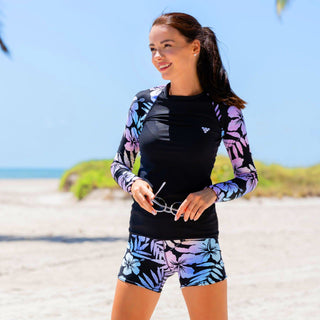SPF or UPF? Which is better, and what's the difference?
When it comes to protecting our skin from the sun, we often hear about SPF (Sun Protection Factor) in sunscreen. However, there is another term that is gaining popularity in the fashion world - UPF (Ultraviolet Protection Factor). While both of these terms are related to sun protection, they refer to different aspects. So, whats the difference between UPF and SPF for clothing. Which is better?
What is UPF?
UPF stands for Ultraviolet Protection Factor, which is a measure of how much UV radiation can penetrate the fabric of clothing. It is similar to the SPF rating system used for sunscreen. The higher the UPF rating of the fabric, the better it is at blocking UV radiation. For example, a fabric with a UPF rating of 50 can block up to 98% of UV radiation.
UPF clothing is specifically designed to protect your skin from the harmful effects of the sun. It is made of tightly woven fabrics that block out UV radiation. Some clothing items may also have chemical additives that further enhance their ability to block UV rays.
What is SPF?
SPF, on the other hand, is a measure of how long it takes for the skin to start burning when exposed to the sun's UVB rays. It is a measure of the effectiveness of sunscreen. For example, if you normally burn after 10 minutes of sun exposure, a sunscreen with SPF 30 will protect you for 30 times longer, or 300 minutes.
SPF is not a measure of protection from UVA rays, which can cause long-term damage to the skin such as premature aging and skin cancer. It is important to look for broad-spectrum sunscreen that protects against both UVA and UVB rays.
What is the difference between UPF and SPF clothing?
The main difference between UPF and SPF clothing is that UPF clothing blocks UV radiation from penetrating the fabric, while SPF sunscreen blocks the UV radiation from damaging the skin. In other words, UPF clothing is a physical barrier, while SPF sunscreen is a chemical barrier.

UPF swimwear and clothing is a great option for individuals who want to protect their skin from the sun without having to apply sunscreen repeatedly. It is especially useful for outdoor activities where the sun is constantly shining, such as hiking, swimming, and fishing.
SPF clothing, on the other hand, is clothing that has been treated with a chemical sunscreen that helps to protect the skin from UV radiation. This type of clothing is usually made from synthetic materials, and the sun protection lasts for a limited amount of time before the clothing needs to be washed or reapplied. It is also not advisable to wear clothing treated with chemicals -for your health, or the health of marine life.
Both UPF and SPF are important for protecting our skin from the harmful effects of the sun. UPF clothing provides a physical barrier against UV radiation, while SPF sunscreen provides a chemical barrier. When it comes to choosing sun-protective clothing, it's essential to look for a high UPF rating (30-50+ is optimal) and broad-spectrum sunscreen for the best protection. With the right protection, you can enjoy your outdoor activities without having to worry about damaging your skin.
Play it safe! Don’t forget the sunscreen. No single sun protection method is foolproof. A complete sun protection strategy should include covering up with clothing, hats, and sunglasses in addition to seeking shade and sunscreen use. UPF clothing with sunscreen is the best way to keep the sunburns at bay.
The Best Fabrics for 30+ and 50+ UPF Protection
UPF (Ultraviolet Protection Factor) is a rating system used to measure the effectiveness of fabrics in blocking out the harmful ultraviolet (UV) radiation from the sun. Fabrics with higher UPF ratings provide better protection against the sun's rays. UPF ratings range from 15 to 50+, with higher numbers indicating greater protection.
For both 30+ and 50+ UPF protection, you'll want to choose fabrics that offer excellent UV-blocking properties. Here are some recommended fabric types for achieving these levels of protection:
For 30+ UPF Protection
1. Cotton - Regular cotton fabrics (such as cotton t-shirts) offer some sun protection, but are typically only 5-15 UPF.
If they are tightly woven, their UPF rating may be higher but may not reach 30+. Look for fabrics labeled as "tightly woven" or "sun-protective cotton."
2. Polyester - Polyester fabrics are often used in activewear and outdoor clothing because they can be engineered to have higher UPF ratings. Look for polyester blends designed for UV protection with tight weaves. Keep in mind, if the apparel garment is stretched too thin, it may hinder the UPF effectiveness. Darker garments are also offer the most UPF protection.
3. Nylon - Similar to polyester, nylon fabrics can be treated to enhance their sun protection properties. Nylon is commonly used in swimwear and outdoor apparel.
4. Bamboo - Bamboo fabric is naturally moisture-wicking and can offer decent sun protection. It's a good choice for lightweight, breathable clothing.
For 50+ UPF Protection
1. High-Quality Polyester and Nylon: Fabrics made from high-quality polyester and nylon fibers, often specifically designed for sun protection, are capable of achieving UPF ratings of 50 or higher. These fabrics undergo special treatments during manufacturing to enhance their UV-blocking properties.
Note: Berry Jane uses Polyester/Spandex blend fabrics with a tight weave for our rash guards and leggings, which provide the best protection. Please be advised that darker colors are best for the most UV protection, as well as properly fitting garments that are not too stretched beyond their UV protection limits.
2. Lycra or Spandex Blends - Fabrics that include Lycra or spandex blends are commonly used in swimwear and activewear. These blends can provide both comfort and excellent sun protection.
3. UPF-rated Clothing - Look for clothing specifically labeled with a UPF rating of 50+. Many brands offer sun-protective clothing for outdoor activities, and these garments are designed to effectively block UV rays.
4. Dark and Dense Fabrics - Dark colors tend to absorb more UV radiation than light colors, providing better protection. Additionally, densely woven fabrics offer improved shielding against UV rays.
5. Tightly Woven Fabrics - Fabrics with tighter weaves naturally have smaller gaps between the threads, making it harder for UV rays to penetrate. This enhances the overall sun protection of the fabric.
When selecting clothing for sun protection, consider the fabric's texture, color, weave, and any additional treatments it may have undergone to boost its UPF rating. It's also important to note that regardless of the fabric, wearing wide-brimmed hats, sunglasses, and using sunscreen on exposed skin are important components of a comprehensive sun protection strategy.

